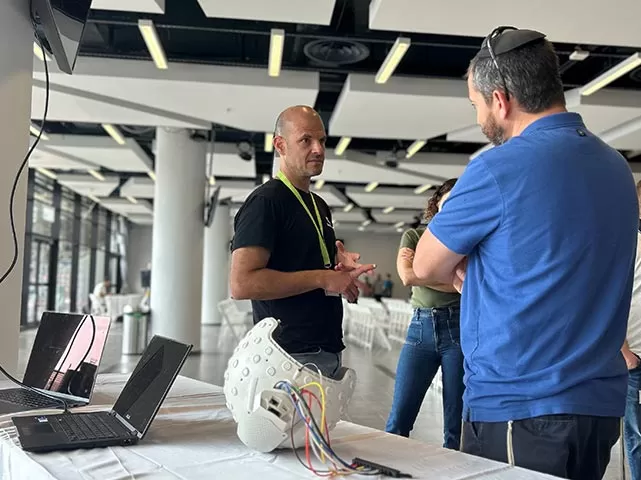
Human Machine Interaction Onstage
From robotic ground vehicles to decision-making engines, Elbit Systems’ conference demonstrated how human-machine interaction is reshaping the future of defense strategies.
How can you strike the perfect balance between human intuition and machine precision on the battlefield? Can AI truly replace the human element in critical defense operations, or is the future focused more on enhancing decision-making rather than replacing it? These pressing questions were at the forefront of discussions at Elbit Systems' recent conference in Haifa.
Over 200 participants, including top engineers and Directorate of Defense Research and Development (DDR&D) officials, gathered at the Sammy Ofer Stadium on September 10th for lectures and presentations from leading experts. Attendees witnessed firsthand the groundbreaking innovations shaping the next generation of defense technologies.
A Fusion of Minds
This year’s event was the second in a series of conferences aimed at advancing human-machine interaction in military systems. Led by Dr. Dima from Elbit's HFE & UX Team, the goal was to create a platform where experts from different divisions could come together, share challenges, insights, and collaborate on the practical integration of the human factor in complex systems.
As Dr. Dima explained, "We're not just showcasing innovation, we are bridging the gap between technology and the people using it in real world applications it. This conference transcends divisions within Elbit Systems, bringing together engineers, subject matter experts, and business leaders under one roof to reflect knowledge back into the industry."
Insights from the Frontlines
At the core of the discussions was the delicate balance between human control and machine autonomy. The conference agenda featured insightful talks on neurotechnology, the challenges of autonomous systems, and the future of human-machine interaction.
Dr. Alona & Dr. Asaf from the DDR&D led a session on enhancing human capabilities through neurotechnology, while other speakers examined AI's role in battlefield decision-making.
One of the standout presentations was the FightLab project, a collaboration that uses operational simulations to study how human factors and autonomy intersect. The lab leads research on human interactions with autonomous systems in high-pressure, dynamic environments.
The Expert Panel Discussion, led by Gil, innovation leader at Elbit Systems, focused on the human factors challenges encountered during the recent Iron Swords War. The session brought together external guests and subject matter experts from Elbit’s Aerospace and C4i Divisions to explore how human-machine interactions were tested under real combat conditions.
Optimizing Systems for User, Role, and Environment
The conference emphasized the critical interaction between humans, their environment, and their roles within systems. These elements shaped how engineers and designers approached user interactions, influencing system design and optimizing user experiences in complex systems.
The Human: Systems needed to consider physical, cognitive, and psychological traits, ensuring inclusive design for diverse users. The Environment: Both natural and built environments, along with nearby equipment, imposed constraints that influenced system design and functionality across various contexts. The Role: A user's position in an organization shaped their interaction with systems, affecting expectations and responses.
Incorporating these factors was essential to designing effective human-machine interfaces aiming for enhanced performance and safety in military operations.
Human Factors integration in the development process
The conference showcased a poster exhibition featuring case studies on potentially groundbreaking defense technologies being developed, including robotic ground vehicle operations, simulation systems' insights platform, advanced thermal sights, and threat management systems. These exhibits offered participants a glimpse into the future of defense technologies while highlighting how human factors engineering best practices were integrated into the development process. The posters demonstrated how user-centric design, cognitive load management, and operational efficiency were prioritized to help ensure that these advanced systems enhance performance and safety in real-world scenarios.
Innovative Technology Demonstrations
Beyond the discussions and case studies, Israeli start-ups also presented their AI-driven innovations, aligning with Elbit’s mission of fostering collaboration and driving technological advancement in the defense sector. These innovations, focusing on both software and hardware solutions for monitoring mental states and enhancing the understanding of how humans interact with systems, provided valuable insights into improving human-system integration and optimizing performance in defense operations.
What’s Next for AI in Defense?
As the conference came to a close, one thing was clear: the future of defense will include an evolving partnership between humans and machines. As AI advances, the challenge ahead is to develop systems that enhance human capabilities while preserving the important role of human decision-making.
Elbit Systems emphasized that the conference was about more than just technology—it was about integrating people with the systems they rely on. By prioritizing human-system integration and fostering collaboration among engineers, military personnel, and innovators, the company is striving to shape the future of defense, by focusing on advanced technologies that enhance human capabilities and decision-making. This focus on seamless interaction between humans and machines positions Elbit Systems as a leader in AI and defense innovation.
The content of the article does not constitute business or financial information about Elbit Systems Ltd. (the "Company") and is not intended to be a basis for making investment decisions in the Company's securities. In order to obtain business or financial information about the Company, please refer to the reports and filings that the Company regularly publishes on the website of the U.S Securities and Exchange Commission (EDGAR) and on the notification system of the Tel Aviv Stock Exchange (Maya).
The article may contain forward-looking statements such as estimates, forecasts, estimates, plans, etc. that refer to future events that are considered forward-looking information as defined under the securities laws of Israel and the United States. There is no certainty that such information will be realized, in whole or in part, and the actual result may differ from what was presented in the article, among other things due to its dependence on external factors that are not under the control of the Company and that cannot be evaluated in advance. The forward-looking statements are based on the Company's estimates at the time of publication, and the Company has no obligation to update or correct this data.



